Spa Design
Efficient Esthetician Spa Floor Plan Design Guide
Take a glimpse into how a thoughtfully designed floor plan can revolutionize the efficiency of an esthetician spa by up to 30% – discover the secrets within.
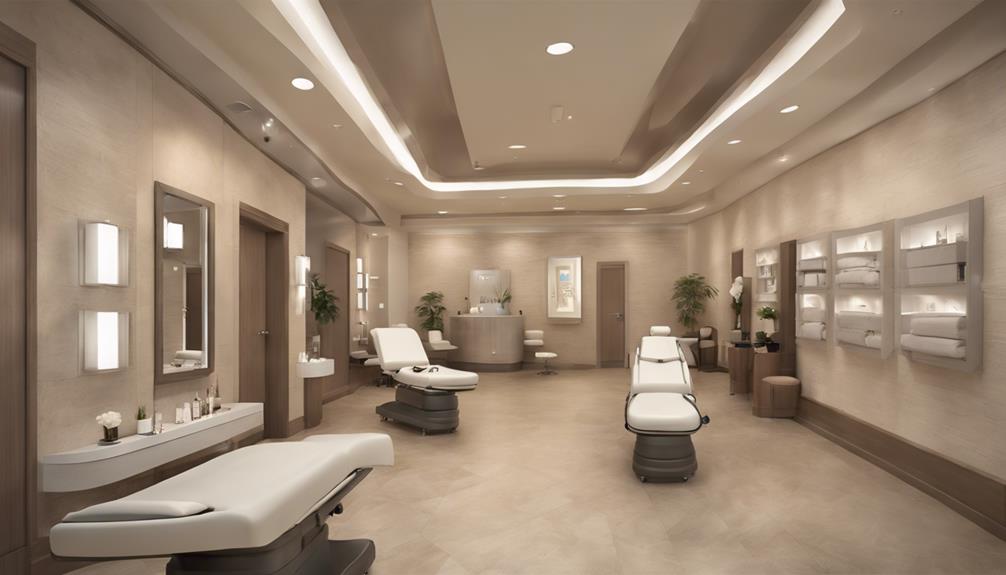
As we explore the realm of spa design, it is fascinating to note that a well-thought-out floor plan can increase operational efficiency by up to 30%.
Understanding how the layout of an esthetician spa impacts workflow, client experience, and overall functionality is crucial in achieving a harmonious environment that caters to both practical needs and aesthetic appeal.
By delving into the intricacies of space planning, traffic flow optimization, and the integration of aesthetic elements, we uncover a world where design meets functionality in the most seamless way possible.
Key Takeaways
- Optimize space and flow for efficient esthetician spa operations.
- Design clear pathways and logical room sequences for smooth client movement.
- Incorporate strategic placement of facilities and amenities for functionality.
- Create a serene and rejuvenating atmosphere with aesthetic elements and thoughtful design.
Space Planning Considerations
When designing an esthetician spa floor plan, our primary focus is on optimizing space utilization to accommodate a range of services efficiently. Considering the number of treatment rooms needed based on services like facials, massages, and waxing is crucial.
Each room must be strategically placed to ensure a smooth flow between different treatments while maximizing privacy for clients. Allocating space for storage of products, linens, and equipment is key to easy access for estheticians during treatments.
By planning for a comfortable waiting area that complements the spa's design aesthetic, we enhance the overall client experience from the moment they enter. The placement of sinks and plumbing fixtures is carefully considered to streamline the esthetician's workflow and improve client comfort.
Additionally, having dedicated consultation areas allows for in-depth discussions about treatment options and product recommendations with clients. These thoughtful space planning considerations not only optimize efficiency but also create a harmonious and functional environment for both estheticians and clients.
Traffic Flow Optimization
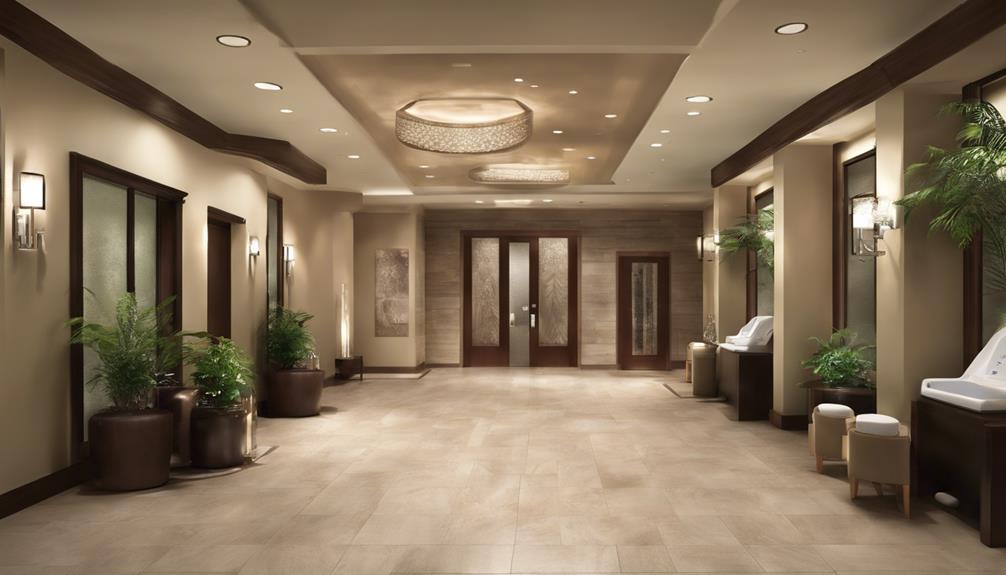
To ensure optimal efficiency and a seamless experience for both clients and staff, strategically organizing the traffic flow within the esthetician spa floor plan is paramount. Here are some key strategies to optimize traffic flow:
- Create Clear Pathways: Design a clear path from the reception area to treatment rooms to streamline client movement and minimize confusion.
- Logical Room Sequencing: Place treatment rooms in a logical sequence to reduce staff and client congestion, enhancing the flow within the spa.
- Separate Entrances and Exits: Implement separate entrances and exits to prevent bottlenecks in high-traffic areas, ensuring smooth transitions for clients and staff.
- Wide Corridors and Doorways: Opt for wide corridors and doorways to accommodate easy movement, allowing clients and staff to navigate the spa space comfortably.
Functional Layout Design
In crafting a functional layout design for an esthetician spa, careful consideration must be given to the strategic placement of treatment rooms, reception areas, and staff zones to ensure an efficient and seamless flow throughout the space. Staff areas such as break rooms and storage should be positioned for easy access without disrupting client spaces, promoting a harmonious environment. Moreover, incorporating accessible restroom facilities for both clients and staff members not only complies with regulations but also enhances convenience for all.
By designating specific zones for different functions like relaxation areas, treatment rooms, and retail spaces, the layout can be optimized to cater to various needs within the spa seamlessly.
To ensure future expansions can be accommodated, flexibility in the floor plan design is crucial. This foresight allows for adaptations to be made easily, accommodating potential growth and changes in the services offered without major disruptions to the overall functionality of the spa.
Aesthetic Elements Integration
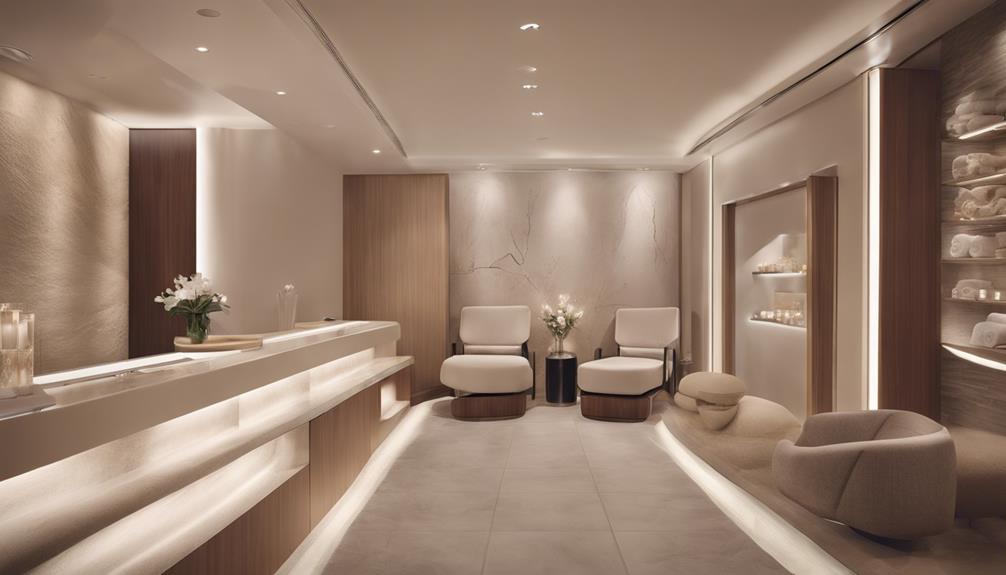
Integrating soothing color schemes and natural elements into the spa design can transform the space into a serene oasis for clients seeking relaxation and rejuvenation. To achieve this, we focus on the following elements:
- Color Schemes: Soft blues and greens are ideal choices to create a calming atmosphere, promoting a sense of tranquility and peace within the spa environment.
- Natural Elements: Incorporating plants and water features brings a touch of nature indoors, enhancing the aesthetic appeal and fostering a connection with the outdoors.
- Quality Materials: Utilizing natural wood and stone elevates the design, infusing a sense of luxury and elegance that resonates with clients seeking a premium experience.
- Lighting Fixtures: Implementing soft, indirect lighting not only illuminates the space but also sets the mood, creating a warm and inviting ambiance that enhances the overall spa experience.
Productivity Enhancement Strategies
Enhancing productivity within the spa environment involves strategically incorporating designated workstations for estheticians to optimize workflow efficiency and minimize unnecessary movement. By implementing storage solutions near treatment rooms, estheticians can easily access products and tools, reducing time spent searching for supplies. Proper lighting in each esthetician station enhances visibility and accuracy during treatments, ultimately improving overall productivity. Additionally, designating a separate area for laundry and cleaning supplies maintains a tidy work environment and streamlines daily tasks for estheticians. Considering ergonomic furniture and equipment is crucial to prevent strain and fatigue, promoting comfort and productivity throughout the day.
| Productivity Enhancement Strategies | Benefits | Implementation Tips |
|---|---|---|
| Designate workstations | Optimize workflow efficiency | Allocate specific areas for each task |
| Implement storage solutions | Easy access to products | Organize supplies for quick retrieval |
| Ensure proper lighting | Enhance visibility | Use adjustable lighting fixtures |
| Separate laundry area | Maintain tidy environment | Regularly organize and restock supplies |
| Ergonomic furniture and equipment | Prevent strain and fatigue | Invest in quality, adjustable pieces |
Frequently Asked Questions
How to Design a Spa Room?
To design a spa room, we focus on size, equipment placement, soothing colors, proper ventilation, lighting, storage, and soundproofing. Our goal is to create a serene space that promotes relaxation for clients and efficiency for estheticians.
How Many Square Feet Do You Need for a Spa?
We need varying square footage based on the spa's size and amenities. A small spa with 2-4 rooms needs 1,000-2,000 sq ft; a medium one with 5-8 rooms requires 2,000-4,000 sq ft. Larger spas with 9+ rooms or extra features need 4,000+ sq ft.
How Do You Design a Salon Layout?
We design a salon layout by optimizing flow, organizing service areas efficiently, and placing equipment strategically for convenience. Incorporating elements like reception desks and prioritizing safety measures enhances the client experience while maximizing space utilization.
How Much Room Does a Salon Chair Need?
Salon chairs need about 4-5 square feet for comfort. With 4 feet of space between chairs, movement is easy. Consider reclining functions for proper clearance. Adequate room allows estheticians to work smoothly. Placement is key for efficiency and comfort.
Conclusion
As we conclude our efficient esthetician spa floor plan design guide, we find that the intersection of functionality and aesthetics isn't merely a coincidence, but a deliberate and thoughtful design approach.
By optimizing traffic flow, integrating aesthetic elements, and enhancing productivity, our meticulously planned spaces create a seamless experience for staff and clients alike.
Let the beauty of design and efficiency coincide in your spa setting for a truly exceptional experience.
- About the Author
- Latest Posts
Introducing Ron, the home decor aficionado at ByRetreat, whose passion for creating beautiful and inviting spaces is at the heart of his work. With his deep knowledge of home decor and his innate sense of style, Ron brings a wealth of expertise and a keen eye for detail to the ByRetreat team.
Ron’s love for home decor goes beyond aesthetics; he understands that our surroundings play a significant role in our overall well-being and productivity. With this in mind, Ron is dedicated to transforming remote workspaces into havens of comfort, functionality, and beauty.
Spa Design
Essential Steps for Spa Design and Construction
Embark on a journey through the vital steps in spa design and construction, where opulence meets innovation for an unparalleled experience.
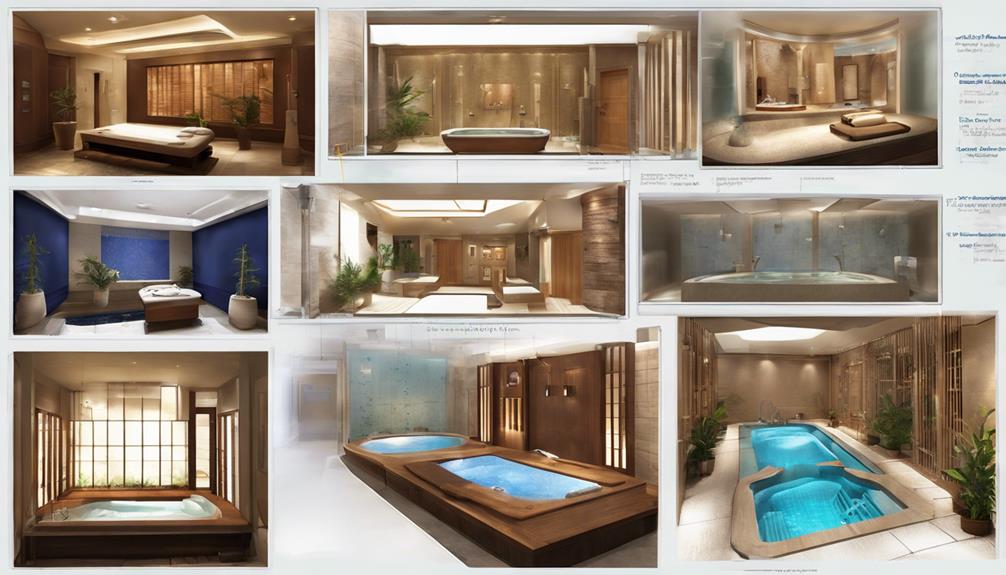
As we navigate the intricate world of spa design and construction, we find ourselves at a crossroads where creativity meets functionality.
The synergy between ambiance and practicality sets the stage for a truly exceptional spa experience.
Join us as we unravel the essential steps that pave the way for the creation of a sanctuary where luxury and comfort intertwine seamlessly, promising a haven that transcends mere relaxation.
Key Takeaways
- Choose a location with utilities, accessibility, and zoning compliance for a soothing spa environment.
- Develop a unique concept based on market research to guide layout and design decisions.
- Allocate budget wisely, including funds for professional design services and contingencies.
- Focus on layout optimization, natural lighting, and proper construction for a successful spa design and construction process.
Location Selection
As we delve into the crucial aspect of selecting the perfect location for your spa, we must prioritize various factors. When considering a location for new construction, it's essential to ensure proximity to amenities such as water, electricity, and a floor drain for a seamless spa setup. Accessibility plays a vital role during the construction phase, ensuring smooth equipment delivery and installation processes.
In terms of compliance, verifying that the chosen location meets zoning regulations and building codes is imperative to avoid any legal complications down the line. Moreover, assessing the natural lighting and ventilation options available at the site is crucial to creating a welcoming ambiance for your spa clientele. These elements are foundational in establishing a soothing environment that aligns with your interior design vision.
Concept Development
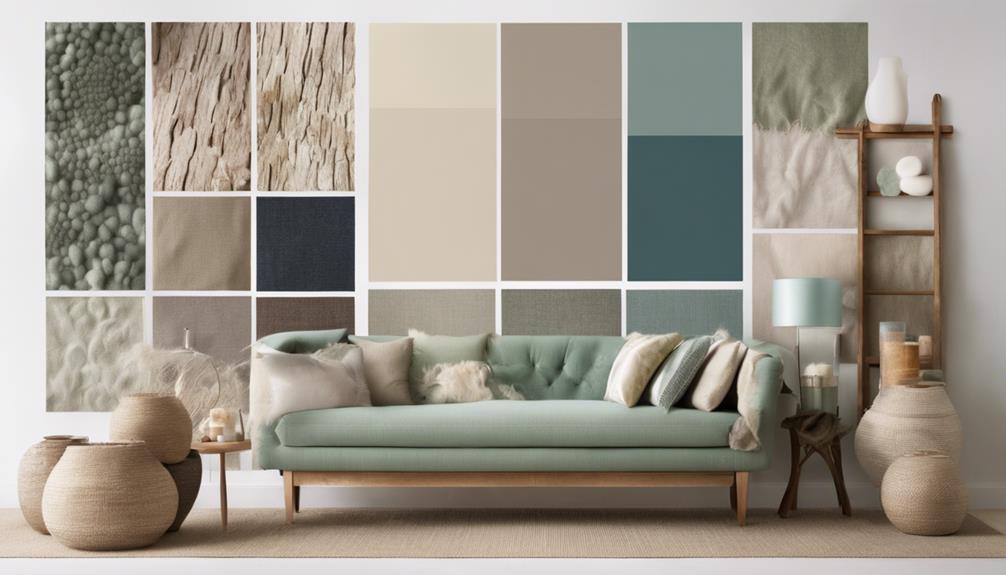
Crafting a compelling and engaging concept is the cornerstone of designing a successful spa experience that resonates with clients on a profound level. When developing the concept for a new spa, working with professional spa consultants can provide valuable insights and expertise. Here is a breakdown of essential steps in concept development:
| Key Steps | Description |
|---|---|
| Define Theme | Create a unique and cohesive theme that defines the overall atmosphere, style, and experience of the spa. |
| Research Market Trends | Conduct thorough research on market trends, client preferences, and competitor analysis to inform the concept. |
| Guide Design Decisions | The concept guides decisions on layout, color schemes, decor, and amenities to ensure a cohesive design. |
| Establish Foundation | A well-developed concept sets the foundation for a successful and appealing spa design. |
| Client Engagement | Involve clients in the concept development process to ensure it resonates with the target audience. |
Budget Planning
When delving into the intricate process of budget planning for a spa design and construction project, our team meticulously considers every financial aspect to ensure a seamless and successful execution.
To achieve this, we allocate a budget range of $15,000 to $45,000 for a basic spa renovation project, factoring in costs for materials, labor, permits, and unforeseen expenses. It's crucial to designate 20% of the budget for professional spa design and planning services, ensuring a tailored and innovative approach.
Additionally, we plan for specialized equipment, lighting, and finishes within the budget to enhance the spa's ambiance and functionality.
To safeguard against unexpected costs during construction, we recommend keeping a contingency fund of 10-15% of the total budget, providing a safety net for any surprises that may arise.
Our thorough budget planning strategy aims to deliver a high-quality spa within financial parameters, prioritizing both creativity and practicality.
Design and Layout Creation

In designing a spa layout, careful consideration must be given to the flow of foot traffic and the accessibility of amenities to ensure a seamless and enjoyable experience for guests. Working with spa consultants can be invaluable when starting from scratch to create a space that maximizes comfort and functionality. One essential aspect to focus on is the distribution of treatment rooms, relaxation areas, and changing rooms to optimize the guest experience. Here is a visual representation of key considerations for spa layout creation:
| Key Considerations | Implementation |
|---|---|
| Flow of Foot Traffic | Create clear pathways |
| Accessibility of Amenities | Ensure easy access to facilities |
| Zoning for Activities | Designate areas for specific functions |
| Natural Light and Ventilation | Utilize windows and skylights |
Construction and Installation
With precision and expertise, we ensure the proper foundation and structural support for spa equipment and features during the construction phase. Following manufacturer guidelines, we meticulously install specialized spa equipment such as steam rooms and hydrotherapy tubs.
Collaborating closely with plumbing and electrical professionals, we guarantee the correct installation of water and power sources, ensuring seamless functionality. Implementing stringent safety measures throughout the installation process is paramount to prevent accidents and adhere to regulations.
Post-installation, we conduct thorough inspections and rigorous testing to certify optimal performance and functionality, providing our clients with a spa that operates flawlessly. Our commitment to excellence in spa construction and installation ensures a space that not only meets but exceeds expectations, delivering a rejuvenating and luxurious experience for all who indulge in its offerings.
- Precision: Every detail matters in creating a spa oasis.
- Collaboration: Working together to bring your spa vision to life.
- Safety: Prioritizing well-being during construction and installation.
- Innovation: Implementing cutting-edge technologies for a modern spa experience.
- Quality Assurance: Testing and inspecting to guarantee top-notch performance.
Frequently Asked Questions
What Do I Need to Build a Spa?
To build a spa, we need a suitable location, essential infrastructure like plumbing and electrical systems, quality materials for durability, specialized equipment such as steam rooms, compliance with regulations, and attention to aesthetics for a serene environment.
What Are the Steps of Body Spa?
In our body spa process, we start with a thorough consultation to understand your needs. Next, we analyze your skin to customize treatments. Then, we help you choose the perfect therapy before offering post-treatment advice for lasting benefits.
What Do I Need to Start up My Spa?
To start up our spa, we need to determine our target market, create a solid business plan, secure permits, invest in quality equipment and decor, and hire skilled professionals. These steps are crucial for a successful spa launch.
How High Should Spa Steps Be?
When determining the height of spa steps, it's crucial to consider comfort, design, and safety. The ideal height may vary based on preferences and spa rim height. Adjustable options can cater to diverse needs and enhance spa accessibility.
Conclusion
In conclusion, the essential steps for spa design and construction aren't just important, they're absolutely critical for creating a truly luxurious and profitable spa experience.
From selecting the perfect location to designing a layout that maximizes relaxation, every detail must be meticulously planned and executed.
By following these steps with precision and care, you can ensure that your spa will stand out as a haven of indulgence and tranquility, attracting discerning clients seeking the ultimate pampering experience.
- About the Author
- Latest Posts
Introducing Ron, the home decor aficionado at ByRetreat, whose passion for creating beautiful and inviting spaces is at the heart of his work. With his deep knowledge of home decor and his innate sense of style, Ron brings a wealth of expertise and a keen eye for detail to the ByRetreat team.
Ron’s love for home decor goes beyond aesthetics; he understands that our surroundings play a significant role in our overall well-being and productivity. With this in mind, Ron is dedicated to transforming remote workspaces into havens of comfort, functionality, and beauty.
Spa Design
What Spa Design Gauges Are Essential for Monitoring Water Temperature?
Tune into the vital spa design gauges that keep water temperatures in check, essential for a harmonious spa experience – discover the intricate balance required!
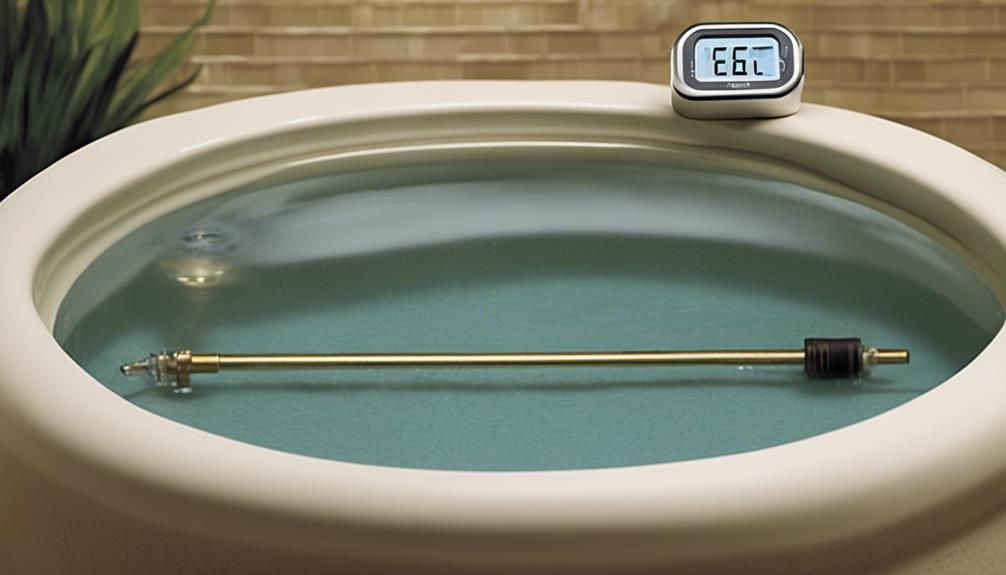
In the realm of spa design, ensuring the water temperature is like keeping a ship on course – it's foundational.
We are about to unfold the essential gauges crucial for this task, shedding light on the precision required for a serene spa experience.
Let's navigate through the intricate world of monitoring water temperature in spa settings and discover the key elements that make a difference in maintaining optimal comfort and safety levels for all spa enthusiasts.
Key Takeaways
- SPA Design dual gauges ensure optimal engine performance and prevent damage.
- Programmable warning lights alert drivers to temperature changes for proactive maintenance.
- Accurate readings in Fahrenheit or Celsius with calibrated sensors for reliable data.
- Real-time monitoring with precision readings prevents engine overheating and damage.
Importance of Water Temperature Monitoring Gauges
Water temperature monitoring gauges are essential for ensuring optimal performance and preventing potential damage due to engine overheating. SPA Design dual gauges stand out for their precision in monitoring water temperature, offering accurate readings that are crucial for maintaining engine health.
Equipped with programmable warning lights, these gauges promptly alert drivers to any deviations in water temperature, allowing for immediate action to be taken. The convenience of being able to switch between Fahrenheit and Celsius display values ensures that users can monitor water temperature in their preferred unit.
SPA Design gauges are further distinguished by their calibrated sensors, which guarantee precise and reliable readings. By utilizing these advanced monitoring tools, drivers can proactively address any issues related to engine overheating, thereby safeguarding the vehicle's performance and longevity.
Investing in quality water temperature monitoring gauges like those offered by SPA Design is a proactive measure that can prevent costly repairs and downtime.
Types of Water Temperature Gauges
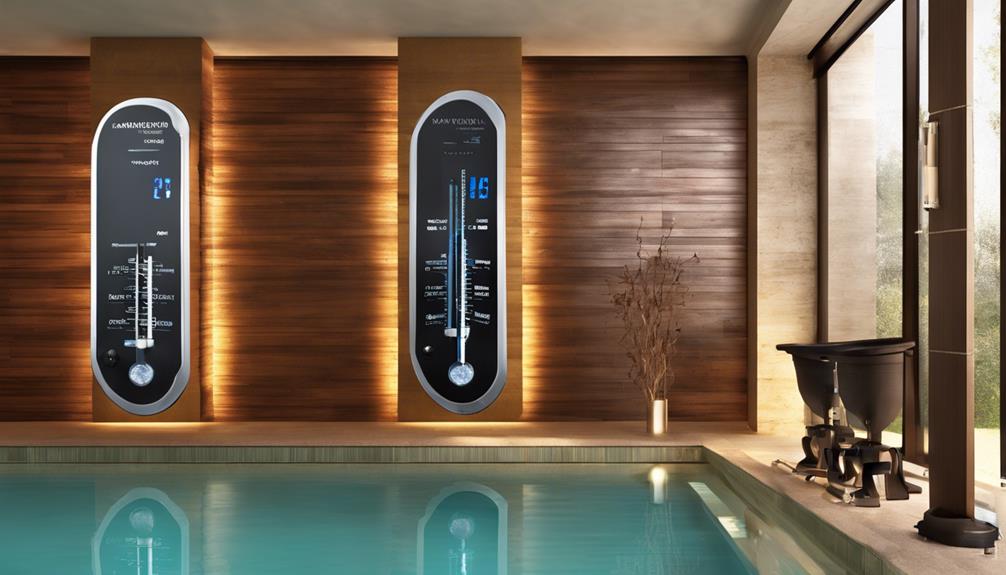
When considering various options for monitoring vehicle parameters, one can explore a range of advanced dual gauges offered by SPA Design that provide comprehensive data on water temperature and oil pressure.
These dual gauges are equipped with microprocessor-controlled technology to ensure accuracy in monitoring water temperature. They feature switchable backlight colors and programmable warning lights specifically designed for water temperature alerts. Users have the flexibility to set the display values in either Fahrenheit or Celsius for water temperature monitoring convenience.
During installation, it's crucial to use correctly calibrated sensors to provide precise water temperature readings. The microprocessor-controlled nature of these gauges enhances their accuracy, making them reliable tools for monitoring critical engine parameters.
SPA Design's dual gauges offer a sophisticated solution for monitoring water temperature and oil pressure simultaneously, catering to the needs of those seeking innovation and precision in their monitoring systems.
Installation and Maintenance Tips
For optimal functionality and reliability of the water temperature gauge, meticulous attention to placement and calibration is imperative. When it comes to installation and maintenance tips for water temperature gauges, here are some key considerations:
- Proper Placement: Ensure the gauge is installed in a location where it can accurately measure the water temperature without any interference.
- Utilize Supplied Sensors: Use the sensors provided with the gauge and follow the manufacturer's installation instructions carefully to ensure accurate readings.
- Regular Calibration: Regularly check and calibrate the gauge to maintain its accuracy over time.
- Monitor Fluctuations: Keep a close eye on any fluctuations in water temperature to detect any issues promptly and prevent overheating.
- Programmable Warning Lights: Make use of the programmable warning lights to receive alerts about any abnormal water temperature levels, allowing for timely intervention.
Benefits of Using Digital Gauges
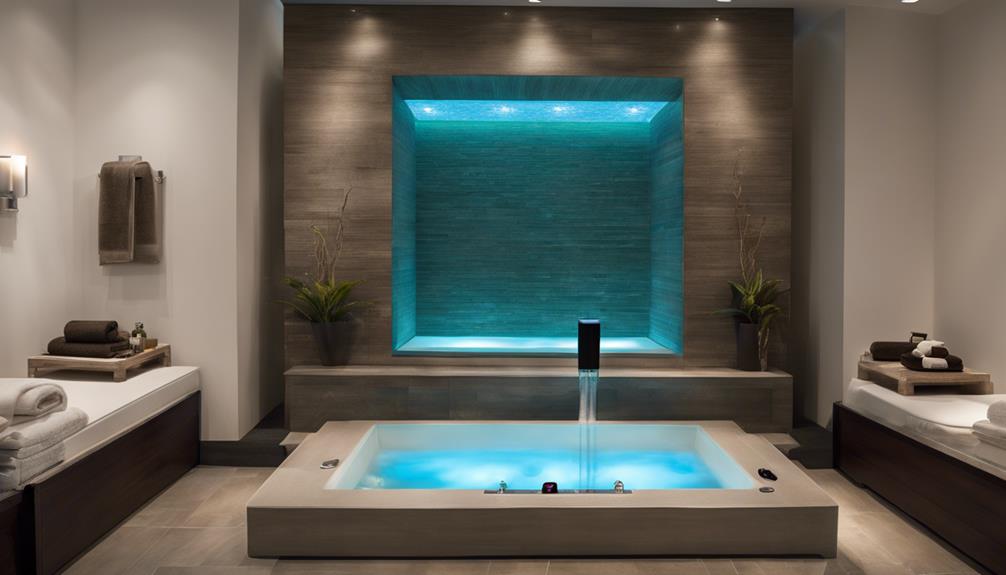
Using digital gauges provides precise and real-time monitoring of water temperature, aiding in preventing overheating and potential engine damage. These high-quality instruments offer precision readings essential for water temperature monitoring in spas. The dual scale digital gauge allows for customizable display values, ensuring a visual representation that suits individual preferences. With a programmable warning light feature, users can set alerts for both high and low temperatures, enhancing engine protection. Additionally, the recall function enables tracking of maximum and minimum values, assisting in identifying temperature fluctuations. The real-time data provided by digital gauges is invaluable for maintaining optimal spa conditions. These gauges not only offer accuracy but also a customizable visual interface, making them a crucial component for any spa design aiming for innovation and efficiency.
| Benefits of Using Digital Gauges | |
|---|---|
| Programmable Warning Light | Real-time Data |
| Recall Function | Dual Scale |
| Customizable Display Values | Precision Readings |
Integrating Gauges Into Spa Design
Integrating gauges into spa design involves strategically positioning the SPA Design dual gauge to monitor water temperature alongside other critical parameters like oil pressure with precision and efficiency.
The SPA Design dual gauge is a versatile tool with a 52mm diameter face and a switchable backlight, offering multiple colors for easy visibility. It features programmable warning lights that alert users to high or low water temperature values, enabling proactive monitoring.
With a microprocessor controlled system, this gauge ensures accuracy and reliability while allowing users to set display values in different units such as °F or °C. The installation process is simplified with included sensors, a wiring harness, and clear instructions, facilitating seamless integration into your vehicle.
When incorporating the SPA Design dual gauge into spa design, users can benefit from a comprehensive monitoring solution that enhances performance and efficiency.
Frequently Asked Questions
What Is the Difference Between Mechanical and Electric Water Temperature Gauges?
Electric water temperature gauges, unlike mechanical ones, utilize sensors for precise data transmission. They offer enhanced accuracy and responsiveness, making them a modern choice. Installation is simplified as no capillary tube routing is needed. Additional features like warning lights and digital displays enhance monitoring capabilities.
What Is the Water Temperature Gauge Sensor?
We rely on the water temperature gauge sensor to precisely monitor engine coolant temperature. It ensures optimal performance and prevents overheating. Located near the engine block, it provides real-time data to the gauge, crucial for engine health.
What Is the Difference Between Mechanical and Electric Gauges?
When comparing mechanical and electric gauges, we find that mechanical gauges utilize physical mechanisms for measurement, while electric gauges rely on sensors and electronic transmission. Each has distinct advantages in precision, display options, and ease of installation.
What Is the Kus Water Temperature Gauge?
We rely on the Kus Water Temperature Gauge for accurate real-time monitoring of engine coolant temperature, preventing overheating. Its clear display, compatibility with various vehicles, and easy installation make it an essential tool for maintaining optimal engine performance.
Conclusion
In conclusion, when it comes to monitoring water temperature in a spa design, selecting the right gauges is crucial. Digital gauges offer precise and reliable readings, with user-settable displays and programmable warning lights for added safety. Integrating these essential elements into the spa design ensures a comfortable and enjoyable experience for users.
Choose gauges with recall functions and easy-to-read displays to effectively monitor water temperature and maintain a relaxing environment.
- About the Author
- Latest Posts
Introducing Ron, the home decor aficionado at ByRetreat, whose passion for creating beautiful and inviting spaces is at the heart of his work. With his deep knowledge of home decor and his innate sense of style, Ron brings a wealth of expertise and a keen eye for detail to the ByRetreat team.
Ron’s love for home decor goes beyond aesthetics; he understands that our surroundings play a significant role in our overall well-being and productivity. With this in mind, Ron is dedicated to transforming remote workspaces into havens of comfort, functionality, and beauty.
Spa Design
Day Spa Interior Design: How to Create a Relaxing Oasis
Meticulously blending materials and motifs, discover the secret to transforming a day spa into a tranquil oasis that captivates the senses.

In designing a day spa interior aimed at crafting a calming oasis, we must meticulously meld materials and motifs to manifest a serene space that soothes the senses and souls of our guests.
But what truly transforms a mere room into a sanctuary of relaxation? Join us as we explore the subtle nuances and strategic selections that can turn an ordinary spa into an extraordinary haven of tranquility, where each element harmonizes to create an ambiance of peace and rejuvenation.
Key Takeaways
- Choose a location with accessibility, privacy, and natural light for a serene ambiance.
- Embrace serene color schemes and natural elements like wood and plants for relaxation.
- Opt for optimal lighting choices with soft, adjustable lighting for a calming atmosphere.
- Incorporate comfortable seating with nature integration and thoughtful spa accessories for a luxurious experience.
Ideal Location Selection
When scouting for the perfect location for our day spa, we prioritize accessibility, privacy, and ample natural light to ensure a serene oasis awaits our guests. Our spa's size plays a crucial role in choosing the right location. A spacious area allows for a well-thought-out layout that accommodates essential design elements like treatment rooms, relaxation lounges, and reception areas. The selected location must offer enough space for these elements to cohesively come together, enhancing the overall ambiance.
Privacy is key in our location selection process. Ensuring that our guests can unwind without disturbances is paramount. Additionally, natural light not only creates a welcoming atmosphere but also has proven benefits for well-being. Placing our spa where natural light can flood in enhances the sense of tranquility and relaxation.
Considering additional features like an outdoor gym area or an outdoor bar to complement the spa experience, the chosen location must have the flexibility to incorporate these elements seamlessly. Our vision for a holistic spa experience starts with the right location, where accessibility, privacy, and natural light converge to create a truly rejuvenating sanctuary for our guests.
Serene Color Schemes
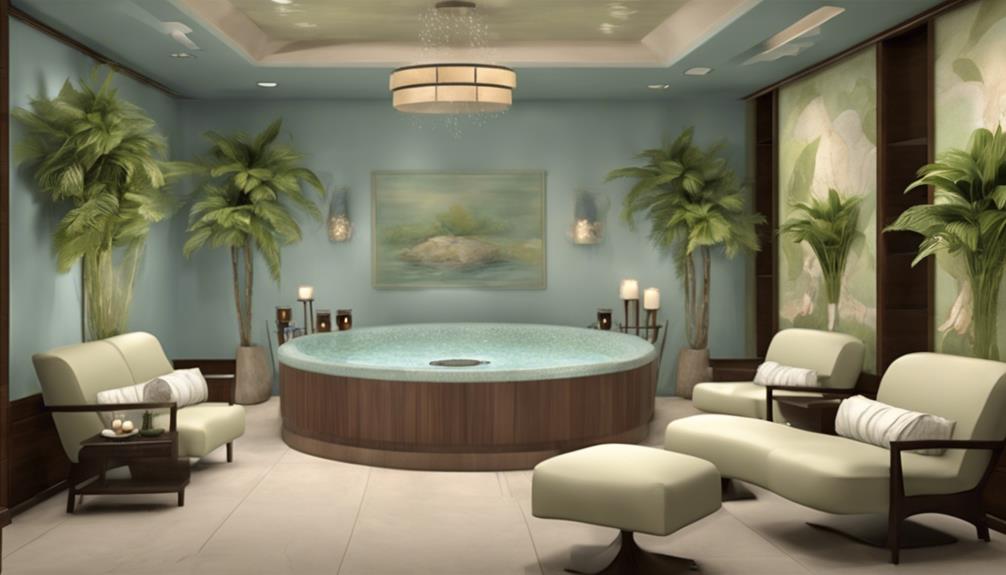
Incorporating serene color schemes like soft blues and calming greens sets the perfect tone for a relaxing day spa ambiance. These soothing colors not only promote a sense of tranquility but also create a serene environment that enhances the overall spa experience.
Here are three key elements to consider when designing a day spa with serene color schemes:
- Pastel Shades: Opting for pastel hues such as gentle pinks and light lavenders can add a touch of softness and elegance to the spa retreat, enveloping guests in a calming atmosphere.
- Earthy Tones: Introducing earthy tones like warm browns and soft beiges can bring a grounding element to the space, connecting visitors with nature and creating a harmonious environment.
- Natural Elements: Incorporating natural elements such as wooden accents, stone features, or indoor plants can further enhance the soothing ambiance, making guests feel like they're in a tranquil oasis surrounded by the beauty of the outdoors.
Optimal Lighting Choices
Our selection of lighting fixtures and placement strategy in the day spa interior design not only illuminates the space but also sets the tone for a serene and rejuvenating atmosphere.
To create a soothing ambiance, we incorporate soft lighting that mimics natural elements like sunlight filtering through leaves. Dimmer switches provide the flexibility of adjustable lighting, allowing us to cater to different treatments and moods throughout the day.
Indirect lighting, such as gentle uplights or soft pendant lights, adds warmth and tranquility to the space, enhancing the overall relaxing atmosphere. By utilizing proper lighting techniques, we ensure that the lighting plays a significant role in promoting relaxation in our day spa setting.
The interplay of light and shadow not only elevates the aesthetics but also contributes to the serene environment we aim to cultivate. Let's guide you through a journey where every beam of light is meticulously designed to enhance your sense of tranquility and well-being.
Comfortable Seating Arrangements
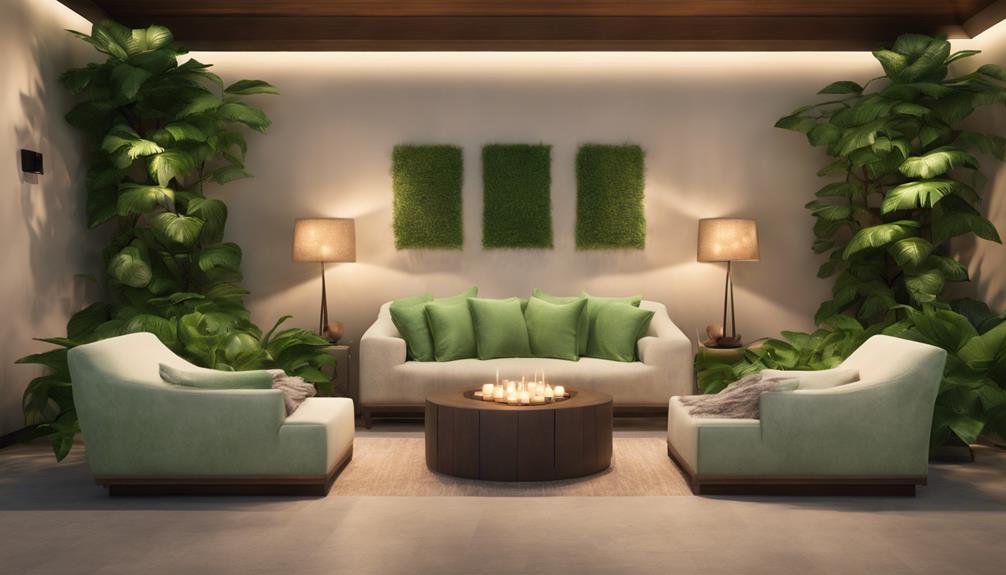
Plush seating adorned with soft cushions beckons guests to unwind and luxuriate in the serene ambiance of our day spa oasis.
Here are three innovative design ideas to create comfortable seating arrangements that enhance relaxation:
- Natural Elements Integration: Incorporate natural elements like wooden furniture or rattan chairs to bring a touch of the outdoors inside. Pair these with plush cushions in earthy tones to create a harmonious connection with nature.
- Water Features: Install seating areas near small indoor water features like fountains or cascading water walls. The sound of flowing water combined with comfortable seating provides a tranquil atmosphere for guests to relax and rejuvenate.
- Storage Solutions with Style: Integrate hidden storage compartments within seating units, such as ottomans or benches, to maintain a clutter-free environment. This not only enhances the aesthetic appeal but also ensures a tidy and organized space for guests to enjoy.
Thoughtful Spa Accessories
To complement the serene ambiance of our day spa oasis, we curate a selection of thoughtful spa accessories that elevate the relaxation and luxury experience for our guests. Our spa embraces natural elements and a cozy farmhouse vibe, setting the mood for ultimate relaxation.
Picture our spa adorned with a decorative wall featuring cascading greenery, including the elegant Snake Plant and the low-maintenance ZZ Plant. As guests step into our rain shower, plush towels await, warmed to perfection by a towel warmer, adding a touch of comfort. The air is filled with the soothing scents of essential oils, enhancing the overall sensory experience.
Our selection of spa accessories, from luxurious bathrobes to scented candles, ensures every detail contributes to the ambiance of tranquility and well-being. Each element is thoughtfully chosen to create a harmonious and luxurious environment where guests can escape the stresses of everyday life.
Frequently Asked Questions
How to Decorate a Day Spa?
To decorate a day spa, we focus on creating a serene oasis. Incorporate natural elements, soft lighting, comfortable seating, and soothing color schemes. Keeping things tidy and well-organized with storage solutions helps maintain a peaceful ambiance for guests to unwind.
How Do I Turn My Living Room Into a Spa?
We can transform our living room into a spa by incorporating calming colors, plush cushions, and soothing music. Adding natural elements like plants and soft lighting enhances the ambiance. Accessories such as candles, oils, and towels elevate the spa experience.
How to Create a Home Spa Room?
To create a home spa room, we designate a serene area, play with calming hues, introduce nature elements, add tech-savvy features, and use ambient lighting and scents. Our oasis includes dedicated relaxation space, tranquil colors, natural touches, tech comforts, and spa-like ambiance.
Conclusion
In conclusion, when designing a day spa interior, it's crucial to focus on creating a serene oasis for ultimate relaxation.
By carefully selecting the ideal location, using calming color schemes, and incorporating optimal lighting choices, we can transform any space into a peaceful retreat.
Remember, the key to a truly relaxing oasis is in the details – so don't be afraid to go above and beyond to create a truly unforgettable experience for your clients.
- About the Author
- Latest Posts
Introducing Ron, the home decor aficionado at ByRetreat, whose passion for creating beautiful and inviting spaces is at the heart of his work. With his deep knowledge of home decor and his innate sense of style, Ron brings a wealth of expertise and a keen eye for detail to the ByRetreat team.
Ron’s love for home decor goes beyond aesthetics; he understands that our surroundings play a significant role in our overall well-being and productivity. With this in mind, Ron is dedicated to transforming remote workspaces into havens of comfort, functionality, and beauty.
-

 Vetted3 weeks ago
Vetted3 weeks ago15 Best Contact Paper for Kitchen Cabinets to Elevate Your Home Decor
-

 Vetted1 week ago
Vetted1 week ago15 Best Poe Cameras for Home Security – Reviews & Buying Guide
-

 Vetted4 weeks ago
Vetted4 weeks ago15 Best Leather Restorer Products to Revive Your Furniture and Accessories
-

 Vetted3 weeks ago
Vetted3 weeks ago15 Best Drain Snakes to Unclog Your Pipes Like a Pro
-

 Beginners Guides20 mins ago
Beginners Guides20 mins agoI Inhaled Vinegar Fumes
-

 Beginners Guides2 weeks ago
Beginners Guides2 weeks agoSwinger Porch Light Color
-

 Vetted3 weeks ago
Vetted3 weeks ago14 Best Stationery Brands for Your Next Writing Adventure
-

 Mardi Gras Decoration3 weeks ago
Mardi Gras Decoration3 weeks agoWhy Does Hobby Lobby Not Do Mardi Gras?
























